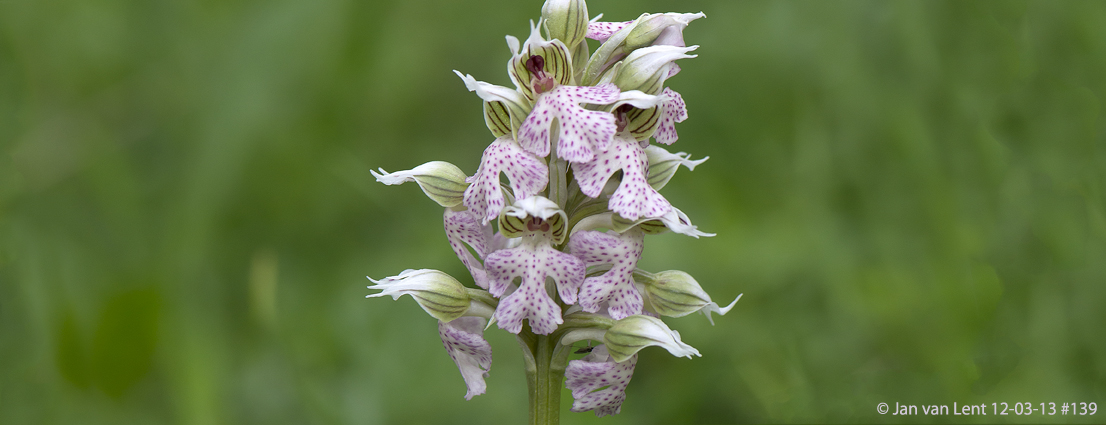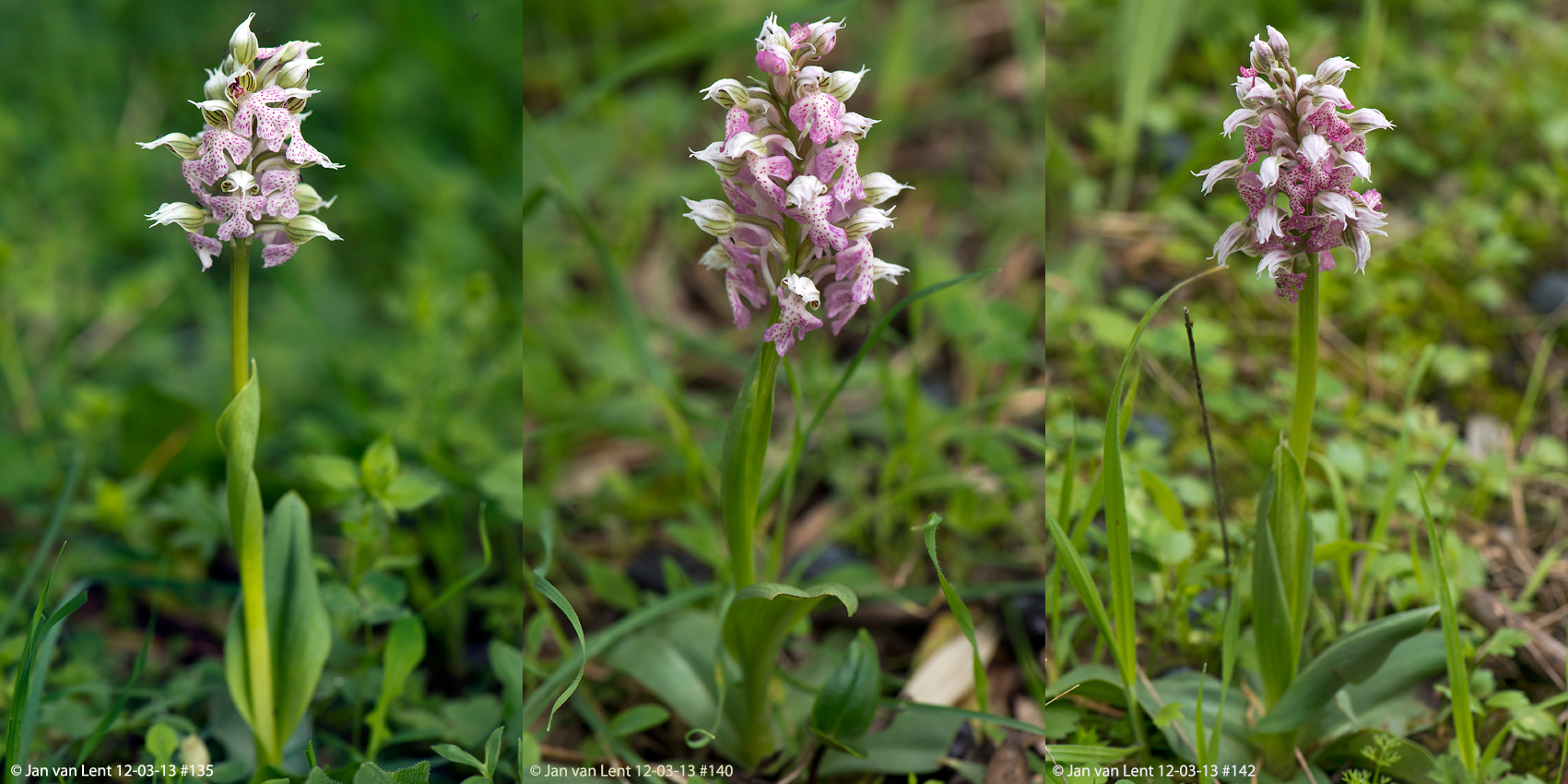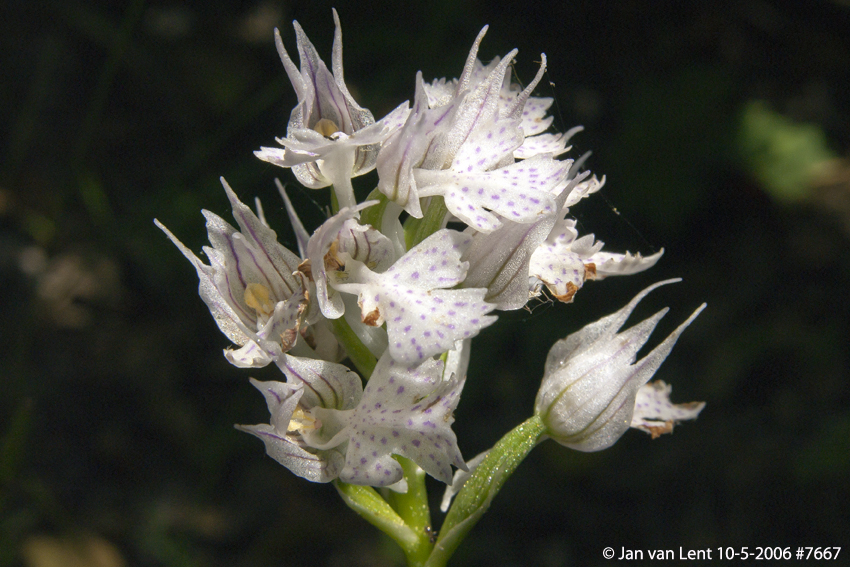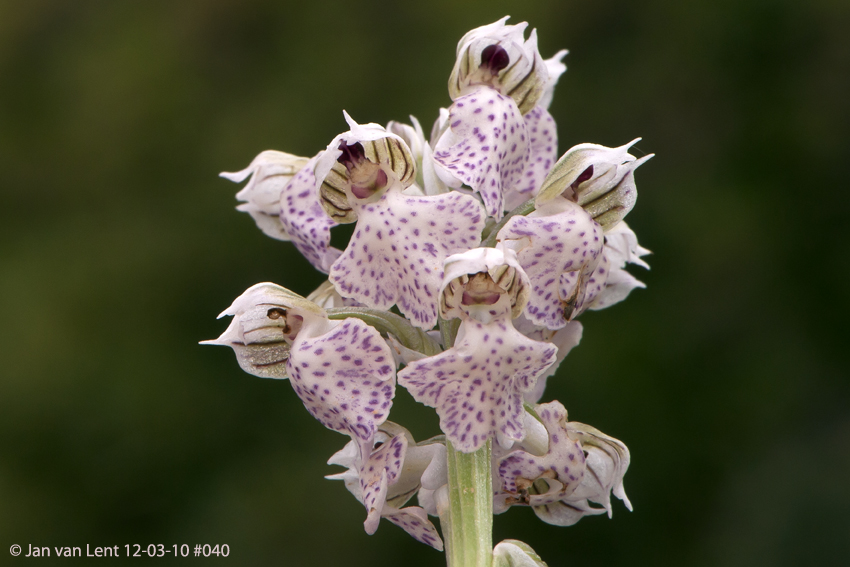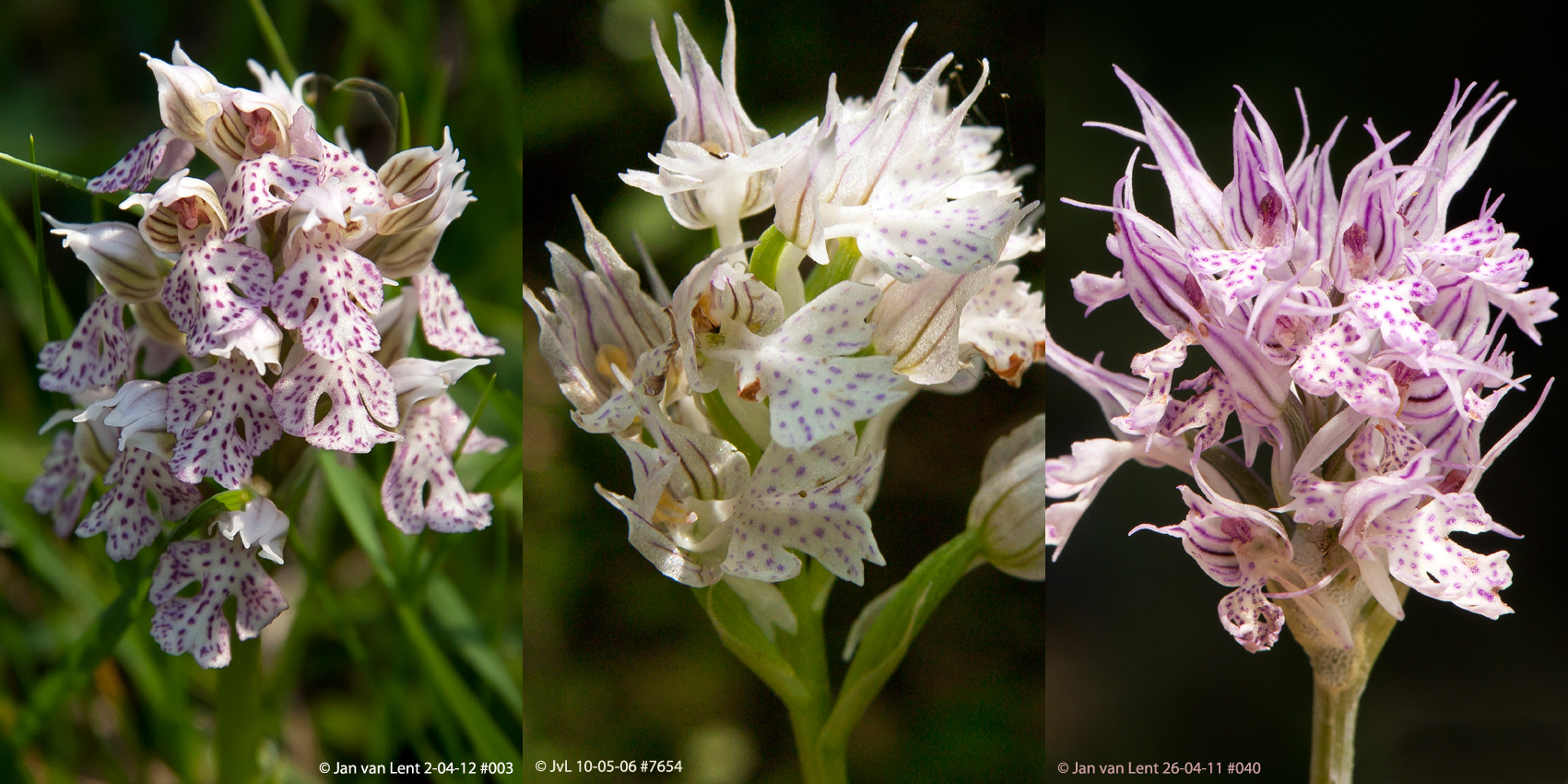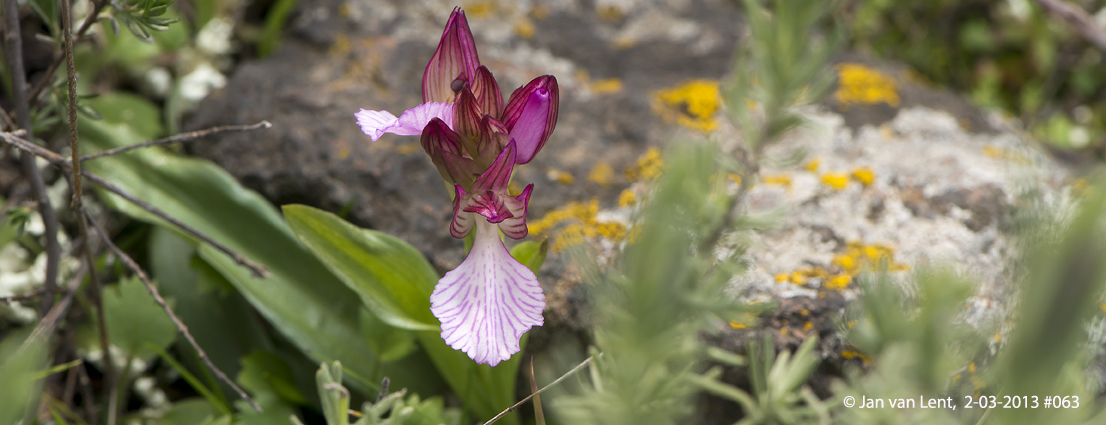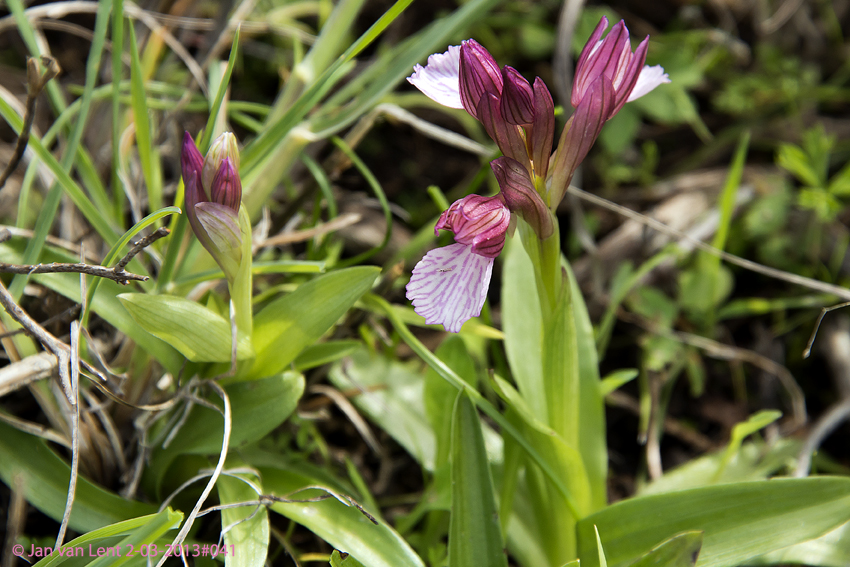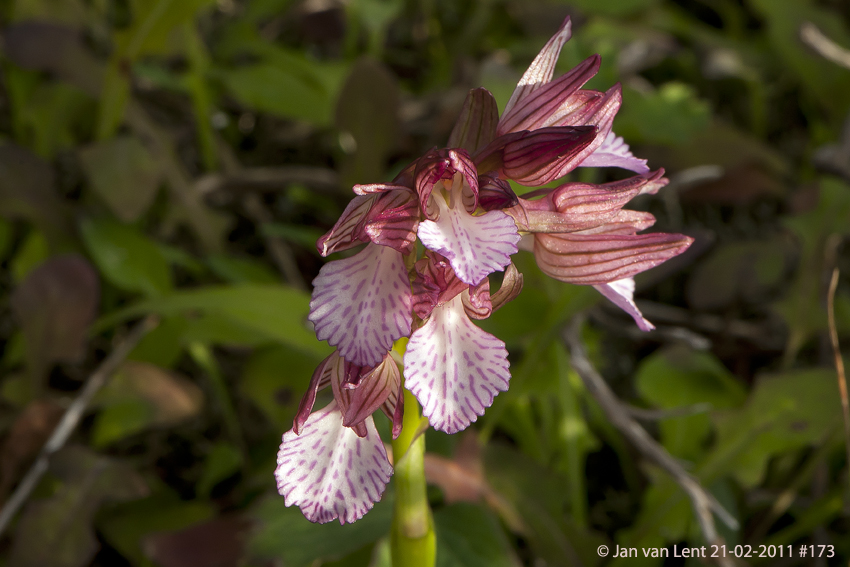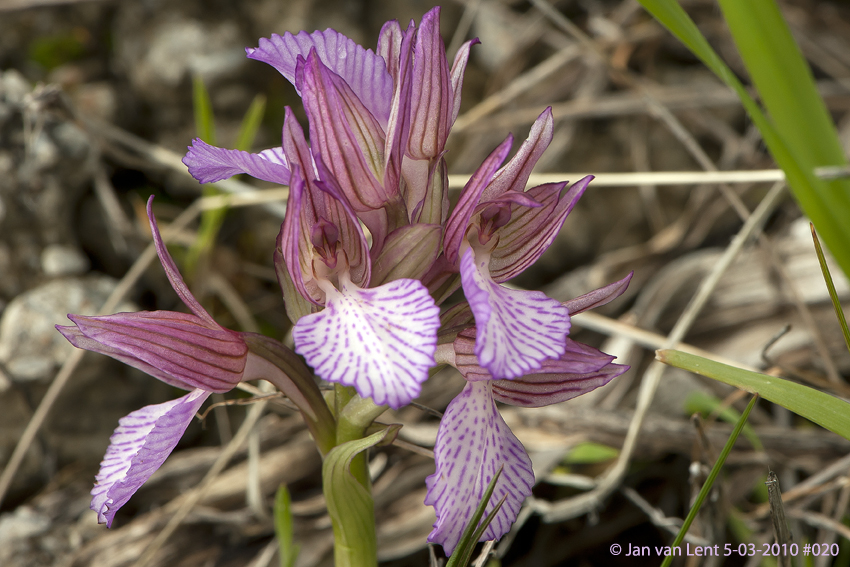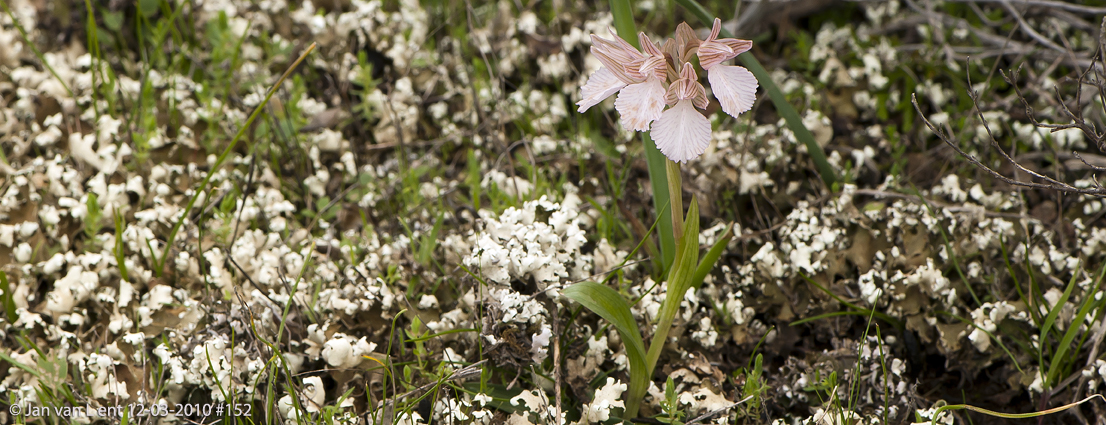Habitats: Lambou Mili to Aqueduct & Kafkares, Palios.
Orchis lactea, Lambou Mili > aqueduct, © Jan van Lent 12-03-13 #139
Orchis lactea Poiret 1798.
SYNONYM:
Neotinea lactea (Poiret 1798) Bateman, Pridgeon & Chase 1997.
The Orchis tridentata-group, on Lesvos Orchis tridentata and Orchis lactea, but maybe also Orchis conica and Orchis commutata.
HUNTING: It can be Greek to (synonym for: seem strange to) go out in the Orchid Paradise when the chance to get wet is almost 100%. But after days of heavy rains you sometimes have to take your chance if you want to go out and photograph Orchids when it is dry, even though it will be just for a few hours. So on the 12th I jumped into my car and drove quickly to Lambou Mili – in the centre of Lesvos – to continue photographing a series of Pseudophrys (among others the new Ophrys sancti-isidorii – see blog 18) next to a parking spot in the pine forest just before the old village itself. After shooting them I decided to walk (with complete camera equipment) to the entrance of the track leading to the old Roman Aqueduct, because the sun was shining, the birds were singing and everywhere you looked I saw masses of beautifully coloured Anemones. So maybe there are also some early orchids to shoot, I thought bearing in mind that in this habitat I found in recent years Ophrys umbilicata, leucadica, sitiaca, pelinaea, leochroma, minutula, Orchis morio picta, lactea and papilionacea.
Orchis lactea, Lambou Mili > aqueduct, © JvL 12-03-13 #135, #140, #142.
HABITAT: Coming into the fields leading to the aqueduct and walking down hill I saw tens of Orchis lactea, the Milky Orchid, flowering between the olive trees, no sign of others – or let alone Pseudophrys yet. So bearing in mind the phrase ‘first come first served’ I decided to work on the Milky Orchid. When I almost reached the aqueduct an enormous bang shuddered through the valley, I looked up (normally I look down, kneel down or I lie down) and saw that the sky was completely black. (I should have seen that before because the existing light was quickly fading away and I had to open my lens more and more and revalue the iso-rating). So I grabbed my equipment (I had already once had a not so pleasant thunder & lighting experience up from Agiasos – see Blog 13 ‘Just A Forest’) so I started running up hill. Well, too late; the first very big raindrops were already hitting me & my camera. In short: before I had reached my car I was soaking wet and my camera still dry. But I had my shots of those very beautiful, just opening and fresh Orchis lactea.
Orchis lactea, Lambou Mili > aqueduct, © JvL 2-04-12 #040
RESEARCH: Until recently I was quickly done with my research on the Milky Orchid, because ‘everybody’ agreed on the morphological appearance, the name, date and author of Orchis lactea Poiret 1798. But ‘things’ are maybe changing because in 1997 R. M. BATEMAN, PRIDGEON & M. W. CHASE reshuffled a lot of species in the genera Aceras, Anacamptis, Neotinea, and Orchis (see also blog 19 ‘Heroes’, Orchis papilionacea). But apparently not everybody was so enthusiastic about this genetic-approach, because until 2007 the authors below did not change the species generic names. So let’s have a quick look at the history of the Orchis lactea name since 1980:
SUNDERMANN (1980): Orchis tridentata ssp. lactea (Poir. 1798 p.sp.) Rouy 1912 and var. albiflora (Macchiati 1881 p.lus.).
KREUTZ (Türkei 1998): Orchis lactea Poir. 1798.
KREUTZ (Rhodos, Karpathos 2002): Orchis lactea Poir. 1798.
KREUTZ (Cyprus 2004): no Orchis lactea on Cyprus.
KRETZSCHMAR ET AL., (Crete & Dodecanense 2004): Orchis lactea.
In their chapter HYBRIDS they show a photograph of Orchis lactea x Orchis tridentata, taken on the 13th of April 2000, so quite early for being O.tridentata and quite late for being O.lactea.
DELFORGE (2005): Orchis lactea Poiret, synonym: Neotinea lactea (Poiret) BPC 1997*. Delforge made an Orchis tridentata group with Orchis lactea, Orchis conica, Orchis tridentata, Orchis commutata, Orchis ustulata and Orchis intacta. Looking at his O.conica I see a lot of resemblance with KRETZSCHMAR’s Orchis lactea x Orchis tridentata. And going through all my lactea and tridentata photographs I found those pictures taken on the 10th of May 2006 (too late for lactea) below Sanatorio (Agiasos).
Orchis conica? Sanatorio Agiasos © JvL 10-5-2006 #7667
BAUMANN et al. (2006) Orchis lactea Poir.
But they also have Orchis lactea ssp. conica (Willd.) Kreutz, which is of course in their opinion a synonym of Orchis lactea and they described Orchis lactea var. conica (Willd.) H.Baumann & R.Lorenz, so from the authors themselves; a very surprisingly new taxon which is not yet clearly separated.
By the way: as a synonym they also have Neotinea lactea (Poiret) BPC 1997*.
KARATZÁ (2007): Orchis lactea Poir. And surprisingly: Orchis tridentata var. commutata, in the Mt.Olympos area, above 600 meters.
CLAESSENS, J. & J. KLEYNEN, (2011): Neotinea lactea (Poiret) BPC 1997*.
PETROU ET AL. (2011): Neotinea lactea (Poiret) BPC 1997*, synonym: Orchis lactea Poiret and Neotinea commutata (Todaro) R.M. Bateman.
TAYLOR (2012): Orchis lactea Poir. 1798.
Orchis lactea or Orchis fetanea? Kafkares > Palios, © JvL 12-03-10 #040
So we have only SUNDERMANN who wrote O. tridentata ssp. lactea; 7 orchidologists who go for Orchis lactea and two who adapted BPC*’s 1997 lactea switch from Orchis to Neotinea.
The three species side by side, © JvL: O. lactea 2-4-12 #003; O. conica 10-5-2006 #7654; O. tridentata 26-4-11 #040.
BOTTOM-LINE: Two years ago I was (on the same date) hunting orchids on the road to Palios, as I approached the Kafkares habitat where I found the year before a lot of Orchis morio and Orchis lactea. Now this habitat was full of cows because some farmers have the habit to put all their livestock – goats, sheep, cows, calves and bulls – into ‘waste’ land, thus: nature. I’m not so afraid of the bulls but if cows have small calves they can mercilessly raise their horns at you. And they eat and trample of course MY orchids into the ground. But I start really looking under and IN the bushes and oh yes, there they were: Orchis lactea. So cows, sheep, milk and Milky Orchids can merge together. And maybe, one day, there will be a new orchid on Lesvos: Neotinea fetanea.
Kafkares, © JvL 12-3-2010 #068, habitat Orchis lactea and Orchis picta.
Jan van Lent, Lesvos, 18-3-2013.
* BPC 1997 stands for ‘genes approved and authorized’ by R. M. BATEMAN, PRIDGEON & M. W. CHASE 1997’, but is much shorter. Maybe I’m even going to make a stamp of it.
‘No Milk Today’ by the ‘famous’ Greek singer Vassilikos (2011).
http://www.youtube.com/watch?v=CJ4HKWl1wRA
And for people who wish to see the original: ‘No Milk Today’ – Herman’s Hermits 1966.
https://www.youtube.com/watch?v=pdw4Ed2sR9c
Latest ‘news’: Himantoglossum robertianum forever vanished (dug up) from Eftalou.
Himantoglossum robertianum in Eftalou, © JvL 7-04-12 #042
Ex Himantoglossum robertianum in Eftalou, © JvL 19-03-13 #012

